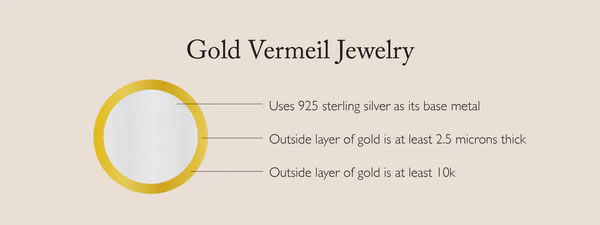What Is Gold Plated, Vermeil, and Solid Gold? Understanding the Differences in Jewelry | CC Jewelry
What is Gold Plated Jewelry?
Gold plated jewelry is the most affordable option among the three. It involves coating a base metal (like brass, copper) with a thin layer of gold through a process called electroplating.
- Process: In electroplating, the jewelry is submerged in a solution containing gold salts and is subjected to an electric current. This causes the gold to bond to the surface of the jewelry, creating a thin coating.
- Thickness: Gold plating is typically much thinner than gold vermeil or solid gold—often just a few microns thick (a micron is one millionth of a meter). This thin coating can wear off over time, especially with regular use.
- Cost: Gold plated jewelry is the most affordable option because it only uses a small amount of gold. This makes it an attractive choice for people on a budget or those who want the look of gold without the high cost.
- Durability: Since the gold coating is thin, gold plated jewelry is less durable than vermeil or solid gold and is more likely to tarnish, fade, or chip over time.
What Is Gold Vermeil?
Gold vermeil (pronounced "ver-may") is a step up from gold plated jewelry, offering a thicker layer of gold and a more luxurious feel. To be classified as vermeil, the jewelry must meet certain standards:
-
Base Metal: Gold vermeil jewelry must be made from sterling silver (92.5% pure silver) as the base metal. This ensures a strong and durable foundation.
-
Gold Layer: To be considered vermeil, the jewelry must have a thicker gold coating than standard gold plating. The gold layer must be at least 2.5 microns thick and made from gold of at least 10k purity (though 14k or 18k gold is more common).
-
Cost: Gold vermeil is more expensive than gold plated jewelry due to the thicker gold layer and higher-quality base metal. However, it is still more affordable than solid gold.
-
Durability: With its thicker gold layer, gold vermeil is more durable than gold plated jewelry. It is less prone to fading or tarnishing and, with proper care, can last for many years. However, it is still not as long-lasting as solid gold.

What Is Solid Gold?
-
Solid gold is exactly what it sounds like: jewelry that is made entirely from gold. Unlike gold plated or vermeil jewelry, solid gold jewelry does not contain any base metal, making it the most luxurious and durable option.
-
Purity: Solid gold comes in different purity levels, typically measured in karats (k). The most common types of solid gold are:
- 24k Gold: Pure gold (99.9% gold). It is soft and not commonly used in jewelry due to its malleability.
- 18k Gold: Contains 75% gold and 25% other metals, providing a balance of purity and durability.
- 14k Gold: Contains 58.3% gold, making it more durable and affordable than 18k gold, while still maintaining a rich gold color.
- 10k Gold: Contains 41.7% gold and is the least expensive solid gold option, but still offers the benefits of solid gold.
-
Cost: Solid gold is the most expensive of the three options because it is made entirely of gold. The price will vary depending on the karat weight and the weight of the jewelry piece.
-
Durability: Solid gold is the most durable and long-lasting option. Unlike gold plated or vermeil, it will not fade, chip, or wear off over time. Solid gold jewelry can last a lifetime with proper care and is resistant to tarnishing.
-
Value: Solid gold jewelry holds its value better than gold plated or vermeil jewelry. If you ever decide to sell or trade it, solid gold can be melted down and recycled, maintaining its intrinsic value.
-
Key Differences Between Gold Plated, Vermeil, and Solid Gold
| Feature | Gold Plated | Gold Vermeil | Solid Gold |
|---|---|---|---|
| Base Metal | Brass, Copper | Sterling Silver (92.5% pure silver) | 100% Gold (with varying karat purity) |
| Gold Layer Thickness | Thin (a few microns) | Thicker (at least 2.5 microns) | N/A (made entirely of gold) |
| Gold Purity | Varies, but usually 10k-24k | At least 10k | 10k, 14k, 18k, 24k |
| Price | Most affordable | More affordable than solid gold | Most expensive |
| Durability | Less durable, may fade or tarnish | More durable than gold plated | Most durable, long-lasting |
| Value | Lower value over time | Retains more value than plated jewelry | Retains intrinsic value, holds up well |
Which Option Is Right for You?
-
-
Gold Plated Jewelry: Ideal for those on a budget who want to wear trendy or costume jewelry but don’t want to spend a lot. Gold plated pieces are perfect for occasional wear but may need replacement over time.
-
Gold Vermeil Jewelry: A great option for those who want the look of solid gold at a more affordable price. Gold vermeil is perfect for everyday wear and can last for many years if properly cared for.
-
Solid Gold Jewelry: The best choice for those who are looking for long-lasting, high-quality pieces that can be passed down through generations. Solid gold is ideal for investment pieces or special occasion jewelry.
-
Final Thoughts
-
-
-
Each of these options—gold plated, vermeil, and solid gold—has its own unique advantages and is suitable for different budgets and purposes. If you’re after something affordable and temporary, gold plated jewelry may be the right choice. If you’re looking for a balance between luxury and affordability, gold vermeil offers a great middle ground. For those seeking timeless value and durability, solid gold is the ultimate option. Regardless of which you choose, each type offers something special to enhance your jewelry collection.
-
-








